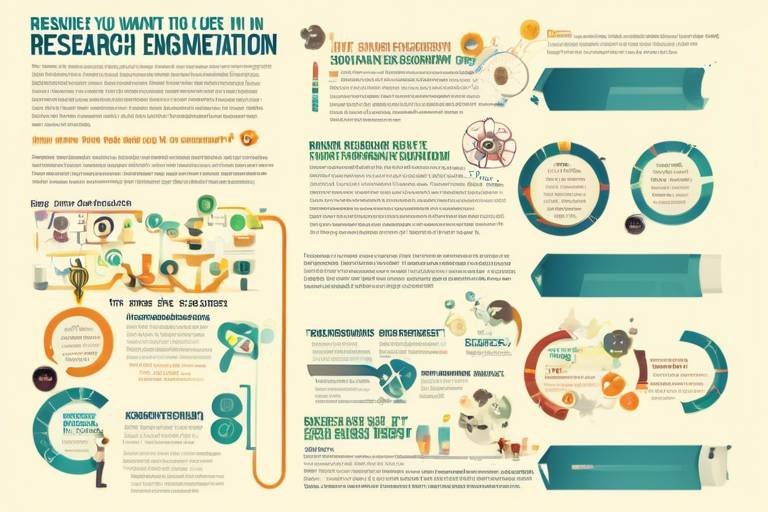The Role of Secondary Data Analysis in Research
In the vast world of research, the quest for knowledge often leads us down various paths, but one of the most intriguing and efficient routes is through secondary data analysis. This method, which involves examining data that has already been collected for a different purpose, can be a game-changer for researchers across multiple disciplines. Imagine having a treasure trove of information at your fingertips, allowing you to explore new insights without the burdensome task of gathering primary data. That's the beauty of secondary data analysis!
Think about it: every day, countless organizations, governments, and institutions collect data. Whether it's census data, health statistics, or market research reports, this information is often sitting in databases, waiting to be utilized. By tapping into these existing resources, researchers can save time, reduce costs, and focus on what truly matters—drawing meaningful conclusions and making impactful decisions.
But why is secondary data analysis so significant? For one, it allows researchers to build on previous studies, creating a rich tapestry of knowledge that can lead to groundbreaking discoveries. Additionally, it provides a unique opportunity to analyze trends over time, offering a longitudinal perspective that primary data collection might miss. It's like having a historical map that guides you through the present and into the future.
Moreover, secondary data analysis can be incredibly versatile. It finds applications in various fields, from healthcare to social sciences and beyond. Each discipline can leverage this approach to enhance research outcomes and inform practice. For instance, in healthcare, researchers can analyze patient records or public health surveys to identify trends in disease outbreaks or treatment efficacy. In social sciences, existing datasets can reveal societal shifts, behavioral patterns, and demographic changes that are crucial for understanding our world.
In summary, the role of secondary data analysis in research cannot be overstated. It not only facilitates a deeper understanding of complex issues but also empowers researchers to make informed decisions based on a wealth of existing information. So, the next time you're embarking on a research project, consider the potential of secondary data analysis—it might just be the key to unlocking new insights!
- What is secondary data analysis?
Secondary data analysis involves using data that has already been collected by someone else, typically for a different research purpose. It allows researchers to analyze existing information rather than collecting new data from scratch.
- What are the main benefits of secondary data analysis?
The primary benefits include cost-effectiveness, time efficiency, and access to large datasets. Researchers can save resources while gaining valuable insights from existing data.
- What challenges might researchers face with secondary data analysis?
Common challenges include concerns about data quality, relevance, and potential biases. Researchers must critically assess the data to ensure it meets their research needs.
- In which fields is secondary data analysis commonly used?
Secondary data analysis is widely used in healthcare, social sciences, marketing, economics, and many other fields, contributing to a diverse range of research outcomes.

Understanding Secondary Data
Secondary data is a term that refers to information collected by someone other than the user for a purpose other than the current research project. Think of it as a treasure trove of insights waiting to be unearthed! Researchers often find themselves sifting through mountains of data that were originally gathered for different studies, surveys, or organizational reports. This data can come from a variety of sources, including government publications, academic journals, and even online databases.
The significance of secondary data in the research process cannot be overstated. It provides a foundation upon which new hypotheses can be built and tested. By utilizing existing data, researchers can save time and resources while still achieving their research objectives. But what exactly makes secondary data so valuable? Let's break it down:
- Accessibility: Secondary data is often readily available, which means researchers can dive straight into analysis without the lengthy process of data collection.
- Diversity of Sources: This type of data can originate from various fields, allowing for interdisciplinary research that can lead to more robust findings.
- Historical Insights: Secondary data can provide historical context that primary data may not capture, enriching the research narrative.
It's essential to understand the different sources of secondary data. These can be broadly categorized into two types:
| Type | Description | Examples |
|---|---|---|
| Publicly Available Data | Data that can be accessed by anyone, often collected by government or non-profit organizations. | Census data, health statistics, educational reports |
| Proprietary Data | Data that is owned by an organization and typically requires permission or payment to access. | Market research reports, private company databases |
Understanding these sources is crucial because it helps researchers evaluate the quality and relevance of the data they plan to use. After all, not all secondary data is created equal! Researchers must consider factors like the original purpose of the data collection, the methodology used, and the context in which the data was gathered. This critical evaluation ensures that the insights drawn from secondary data are both valid and reliable.
In summary, secondary data is a vital component of the research landscape. It offers a wealth of information that can significantly enhance the research process, provided that researchers approach it with a discerning eye. By understanding the various sources and types of secondary data, researchers can unlock new avenues for inquiry and discovery.

Benefits of Using Secondary Data
When it comes to research, time and resources are often in short supply. This is where secondary data analysis shines like a beacon of hope! By utilizing data that has already been collected, researchers can dive into their projects without the daunting task of gathering primary data from scratch. Imagine trying to fill a swimming pool with a garden hose—slow and tedious, right? Now, think of secondary data as a fire hydrant, gushing with information. This approach not only expedites the research process but also opens up a treasure trove of insights.
One of the standout advantages of using secondary data is its cost-effectiveness. Conducting primary research can be a financial burden, involving expenses for surveys, interviews, and data collection tools. On the other hand, secondary data is often available at little to no cost. Researchers can access government databases, academic journals, and public records without breaking the bank. This means that smaller organizations or independent researchers can compete with larger institutions, leveling the playing field in the world of research.
Moreover, secondary data provides researchers with the ability to analyze large datasets that would be challenging to compile independently. Consider this: if you were trying to analyze the impact of climate change on global temperatures, collecting individual temperature readings from all over the world would be a Herculean task. However, secondary data from reputable climate organizations can provide extensive datasets that are already aggregated and analyzed. This access to vast amounts of information allows for more comprehensive analyses and can lead to groundbreaking discoveries.
Let’s dig a little deeper into the cost-effectiveness aspect. Secondary data can significantly reduce research costs for several reasons:
- No Need for Data Collection: Since the data already exists, there’s no need to invest in data collection tools or personnel.
- Reduced Labor Costs: Researchers can save on labor costs associated with data gathering and processing.
- Access to Established Databases: Many organizations provide free access to their databases, which can be a goldmine for researchers.
In essence, the financial savings from using secondary data can be redirected toward other critical areas of research, such as data analysis software or additional studies. This not only enhances the quality of the research but also maximizes the impact of the funding available.
Another compelling benefit of secondary data analysis is its time efficiency. In the fast-paced world we live in, researchers often face tight deadlines. By leveraging existing data, they can focus on analysis rather than getting bogged down in the data collection process. This is akin to having a pre-cooked meal ready when you’re starving; it saves you from the hassle of cooking from scratch. Researchers can quickly move from the data collection phase to data analysis, allowing them to draw conclusions and make recommendations sooner.
Access to extensive datasets is crucial for producing reliable and valid research outcomes. Secondary data often includes comprehensive datasets that are difficult or impossible to gather independently. For instance, national census data provides a wealth of information about population demographics, economic status, and social behaviors, all in one place. Researchers can utilize these datasets to identify trends, correlations, and anomalies that would be hard to spot with limited data.
In summary, the benefits of using secondary data are numerous and impactful. From cost savings to time efficiency and access to large datasets, secondary data analysis empowers researchers to conduct high-quality research without the extensive burden of primary data collection. It’s like having a shortcut in a maze, leading you straight to the exit!

Cost-Effectiveness
When it comes to conducting research, one of the most pressing concerns for researchers is often the budget. Research can be an expensive endeavor, especially when it involves collecting primary data. This is where secondary data analysis truly shines, offering a cost-effective solution that allows researchers to maximize their resources while still obtaining valuable insights.
By utilizing data that has already been collected, researchers can significantly reduce their expenses. For instance, instead of investing in surveys, interviews, or experiments, they can tap into existing datasets from various sources such as government reports, academic publications, or even private organizations. These datasets often come at little to no cost, making them an attractive option for researchers working within tight budgets.
To illustrate this point, consider the following table that compares the costs associated with primary data collection versus secondary data analysis:
| Aspect | Primary Data Collection | Secondary Data Analysis |
|---|---|---|
| Cost | High (e.g., $5,000 - $20,000) | Low (e.g., $0 - $1,000) |
| Time Required | Weeks to Months | Days to Weeks |
| Data Freshness | Current | Variable |
This table highlights the stark contrast in costs and time associated with each method. While primary data collection can run into thousands of dollars, secondary data analysis can often be achieved at a fraction of the cost. Additionally, the time saved in gathering insights allows researchers to allocate their resources more effectively, focusing on analysis and interpretation rather than data collection.
Moreover, secondary data analysis opens the door to a wealth of information that may not be feasible to gather independently. Researchers can access large datasets that provide a comprehensive view of their subject matter. This access not only enhances the quality of their analysis but also allows for more robust conclusions drawn from a broader context.
In summary, the cost-effectiveness of secondary data analysis makes it an invaluable tool in the researcher's toolkit. By leveraging existing data, researchers can save both time and money, allowing them to focus on what truly matters: generating insights that can lead to impactful decisions and innovations.

Time Efficiency
When it comes to research, time is often of the essence. Imagine you’re a researcher with a tight deadline, and the clock is ticking. You need to gather data, analyze it, and produce results—all while juggling other responsibilities. This is where secondary data analysis shines like a beacon of hope. By utilizing existing datasets, researchers can dramatically reduce the time spent on data collection, allowing them to focus on analysis and interpretation instead.
Think about it: if you were to collect primary data, you’d need to design surveys, conduct interviews, or perform experiments, which can be incredibly time-consuming. Not to mention, the process of recruiting participants and ensuring that data is collected correctly can add weeks or even months to your timeline. In contrast, secondary data analysis allows you to hit the ground running. You can dive straight into the data, analyze it, and generate insights without the lengthy setup process.
Moreover, secondary data often comes from reputable sources such as government agencies, academic institutions, or established organizations, which means that the data is typically well-documented and reliable. This reliability enables researchers to quickly assess the quality and relevance of the data, further speeding up the research process. In essence, secondary data acts like a shortcut on a long road, allowing researchers to reach their destination faster and more efficiently.
Here are a few reasons why secondary data analysis enhances time efficiency:
- Immediate Availability: Secondary data is readily available, meaning researchers can start their analysis almost immediately.
- Less Setup Time: The absence of data collection processes means researchers can bypass the tedious setup phase.
- Faster Insights: With data in hand, researchers can focus on drawing conclusions and making recommendations without delay.
In summary, secondary data analysis not only saves time but also allows researchers to maximize their productivity. By leveraging existing data, researchers can complete their projects more swiftly, leading to timely results that can inform decision-making and policy. So, the next time you find yourself pressed for time in a research project, consider the power of secondary data analysis—it might just be the game-changer you need.
- What is secondary data? Secondary data refers to information that has been collected by someone else for a different purpose.
- What are the main benefits of using secondary data? The main benefits include cost-effectiveness, time efficiency, and access to large datasets.
- Can secondary data be unreliable? Yes, the quality and relevance of secondary data can vary, so it's essential to assess the source and context of the data.
- In which fields is secondary data analysis commonly used? It is commonly used in healthcare, social sciences, marketing, and many other disciplines.

Access to Large Datasets
In today's data-driven world, the ability to access large datasets is like having a treasure map in a vast ocean of information. Secondary data analysis opens the door to a plethora of existing data sources, enabling researchers to dive deep into extensive pools of information without the arduous task of collecting it themselves. Imagine being able to analyze data from thousands of respondents across various demographics without ever having to conduct a single survey. This is the power of secondary data!
These datasets can come from a variety of sources, including government databases, academic research, and even commercial entities that collect consumer data. With just a few clicks, researchers can access comprehensive data that would otherwise take months or even years to gather. For instance, consider the following sources where large datasets can be found:
- Government Agencies: Organizations like the Census Bureau or the Centers for Disease Control and Prevention (CDC) provide extensive datasets that are invaluable for research.
- Academic Institutions: Universities often conduct large-scale studies and make their data publicly available for further research.
- Commercial Data Providers: Companies that specialize in data collection offer datasets for purchase, allowing researchers to access high-quality information.
Furthermore, the ability to analyze these large datasets can lead to more robust conclusions and insights. Researchers can perform complex analyses, such as regression models or machine learning algorithms, on vast amounts of data to uncover trends and correlations that may be invisible in smaller datasets. This not only enhances the validity of their findings but also contributes to more informed decision-making across various fields.
However, it’s essential to approach secondary data with a critical eye. While the sheer volume of data available can be an advantage, researchers must ensure that the datasets they choose are relevant to their specific research questions and are of high quality. Data quality issues, such as inaccuracies or outdated information, can skew results and lead to misleading conclusions. Therefore, careful consideration and validation of the data sources are crucial steps in the research process.
In summary, accessing large datasets through secondary data analysis can significantly enrich research endeavors. It provides researchers with the tools to explore vast amounts of information efficiently, ultimately leading to deeper insights and more impactful outcomes.
- What is secondary data analysis?
Secondary data analysis involves the use of existing data that was collected for a different purpose. Researchers analyze this data to answer new research questions. - What are some common sources of secondary data?
Common sources include government databases, academic research publications, and commercial data providers. - What are the challenges of using secondary data?
Challenges include data quality, relevance to the current research question, and potential biases inherent in the original data collection.

Challenges of Secondary Data Analysis
While secondary data analysis offers a myriad of advantages, it is not without its challenges. One of the most significant hurdles researchers face is ensuring the quality of the data. Since this data was originally collected for different purposes, it may not meet the specific needs of the current research. For instance, the methodology used to gather the data might have biases that skew the results. Researchers must critically assess the source and credibility of the data before drawing any conclusions.
Another challenge is the relevance of secondary data. The context in which the data was collected can greatly influence its applicability to new research questions. For example, demographic data from a decade ago may not accurately reflect current societal trends. Researchers must be cautious about applying outdated information to contemporary issues, as this can lead to misleading insights.
Moreover, secondary data analysis often comes with the risk of potential biases. These biases can stem from various sources, including the original data collectors’ motivations or the specific population samples used. To mitigate this, researchers should consider employing multiple datasets to triangulate their findings. By comparing different sources, they can gain a more comprehensive understanding and reduce the likelihood of drawing erroneous conclusions.
Additionally, navigating the legal and ethical considerations surrounding the use of secondary data can be a complex task. Researchers must ensure they have the right to use the data and that it complies with privacy regulations. This is particularly crucial in fields like healthcare, where sensitive information is often involved. Violating these regulations can lead to serious consequences, not only for the researchers but also for the institutions they represent.
In summary, while secondary data analysis is a powerful tool in research, it is essential to approach it with a critical eye. By acknowledging and addressing these challenges—data quality, relevance, biases, and legal considerations—researchers can better harness the potential of secondary data to derive meaningful insights.
- What is secondary data analysis? - It refers to the process of analyzing data that has been collected by someone else for a different purpose.
- What are the main benefits of using secondary data? - Secondary data is cost-effective, time-efficient, and provides access to large datasets.
- What challenges should researchers be aware of? - Researchers should consider data quality, relevance, potential biases, and legal/ethical issues.
- How can biases in secondary data be mitigated? - By using multiple datasets to triangulate findings and ensuring a critical assessment of data sources.

Applications in Various Fields
The versatility of secondary data analysis is one of its most compelling attributes, allowing researchers to apply it across a multitude of disciplines. From healthcare to social sciences and marketing, the insights gained from existing data can drive impactful decisions and enhance understanding in various fields. Let’s take a closer look at how secondary data analysis is utilized in these areas.
In the realm of healthcare, secondary data analysis is indispensable. Researchers often rely on existing health records, surveys, and public health databases to identify trends and outcomes that inform policy-making and clinical practices. For instance, by analyzing data from national health surveys, researchers can uncover patterns in disease prevalence, treatment efficacy, and health disparities among different populations. This not only aids in advancing public health initiatives but also supports the allocation of resources where they are most needed.
Furthermore, secondary data analysis enables researchers to conduct longitudinal studies without the extensive time and financial investment required for primary data collection. By examining historical data, they can track changes over time and assess the impact of interventions or policies. This approach is particularly beneficial in evaluating the effectiveness of public health campaigns or changes in healthcare delivery systems.
Moving on to the social sciences, secondary data plays a pivotal role in understanding societal trends and behaviors. Researchers often utilize large datasets from governmental and non-governmental organizations to analyze demographics, social issues, and public opinion. For example, census data can reveal shifts in population characteristics, such as age, ethnicity, and income levels, which are crucial for social policy development.
Moreover, secondary data allows for the exploration of complex social phenomena without the need for intrusive data collection methods. Researchers can investigate relationships between variables, such as education levels and employment rates, using existing datasets. This not only saves time but also enhances the reliability of findings, as the data has often been collected through rigorous methodologies.
In the field of marketing, secondary data analysis is a powerful tool for understanding consumer behavior and market trends. Companies frequently analyze existing market research reports, sales data, and customer feedback to inform their marketing strategies. By leveraging this data, businesses can identify target demographics, assess market needs, and develop products that resonate with consumers.
Additionally, secondary data can provide insights into competitive landscapes. For instance, analyzing industry reports can help businesses understand market share, pricing strategies, and emerging trends, enabling them to make informed decisions that enhance their competitive edge.
In summary, the applications of secondary data analysis are vast and varied, providing invaluable insights across multiple disciplines. By harnessing existing information, researchers can uncover trends, inform policy, and drive innovation, all while saving time and resources. As the world continues to generate an overwhelming amount of data, the importance of secondary data analysis will only grow, making it an essential tool for researchers and professionals alike.
- What is secondary data analysis?
Secondary data analysis involves examining data that has already been collected by others for a different purpose, allowing researchers to derive new insights without the need for primary data collection. - What are the benefits of using secondary data?
Some key benefits include cost-effectiveness, time efficiency, and access to large datasets, which enable researchers to conduct thorough analyses without the burden of collecting new data. - In which fields is secondary data analysis commonly used?
It is widely used in healthcare, social sciences, marketing, and many other disciplines, providing valuable insights and enhancing research outcomes. - What challenges does secondary data analysis present?
Challenges include issues related to data quality, relevance, and potential biases, which researchers must carefully consider when interpreting results.

Healthcare Research
In the realm of , secondary data analysis has emerged as a powerful tool that allows researchers to glean insights from existing datasets without the need for primary data collection. This approach is particularly significant in an era where the speed of research can be critical to patient outcomes and public health initiatives. By tapping into data that has already been collected, researchers can focus on understanding trends, evaluating treatment effectiveness, and shaping health policies based on solid evidence.
One of the most compelling aspects of secondary data analysis in healthcare is its ability to inform public health studies. For instance, data from national health surveys or electronic health records can be utilized to track the spread of diseases, monitor health trends, and assess the impact of interventions over time. This not only enhances the understanding of health issues but also assists in resource allocation and planning at various levels of healthcare systems.
Moreover, secondary data can play a pivotal role in policy-making. Policymakers rely on comprehensive data analyses to make informed decisions about health regulations, funding, and program implementations. By analyzing existing data, researchers can identify gaps in healthcare delivery, disparities in health outcomes, and areas needing improvement. This evidence-based approach ensures that policies are not just well-intentioned but are also grounded in actual data.
However, it is essential to recognize that while secondary data offers numerous advantages, it also comes with its own set of challenges. Issues such as data quality, relevance, and potential biases must be carefully considered. For example, if the original data collection methods were flawed or if the data is outdated, the insights drawn from it may lead to incorrect conclusions. Therefore, researchers must critically evaluate the source and context of the secondary data they are analyzing.
| Advantages of Secondary Data in Healthcare | Challenges of Secondary Data in Healthcare |
|---|---|
| Cost-effective | Data quality concerns |
| Time-saving | Potential biases |
| Access to large datasets | Relevance to current research questions |
In summary, secondary data analysis serves as a vital component in healthcare research, allowing for rapid insights and informed decision-making. As researchers continue to harness the power of existing data, the potential for improving patient outcomes and enhancing public health initiatives grows exponentially. The key is to approach this data with a critical eye, ensuring that the conclusions drawn are both valid and applicable to current healthcare challenges.
- What is secondary data analysis? Secondary data analysis involves the use of data that has been collected by someone else for a different purpose, allowing researchers to analyze existing datasets rather than collecting new data.
- What are the benefits of using secondary data in healthcare research? Secondary data analysis is cost-effective, time-efficient, and provides access to large datasets, which can enhance the quality and speed of research.
- What challenges should researchers be aware of when using secondary data? Researchers must consider data quality, relevance, and potential biases in the datasets they analyze to ensure accurate and reliable findings.

Social Sciences
In the realm of social sciences, secondary data analysis is like a treasure chest filled with insights waiting to be uncovered. Researchers in this field often find themselves navigating through a vast ocean of existing data, which can be a game-changer for their studies. By tapping into previously collected information, they can analyze societal trends, behaviors, and issues without the need to embark on time-consuming data collection processes.
One significant advantage of utilizing secondary data in social sciences is the ability to draw from diverse sources. This could include government reports, academic publications, or even data from non-profit organizations. Each of these sources contributes to a richer understanding of complex social phenomena. For instance, a researcher studying the impact of education on employment rates can leverage census data, surveys, and educational statistics to paint a comprehensive picture of the situation.
Moreover, secondary data analysis allows researchers to examine historical trends. By looking at data collected over time, they can identify patterns and shifts in societal behaviors that might not be apparent in a single study. For example, analyzing historical voting data can reveal changes in political engagement among different demographics, providing valuable insights for policymakers and political strategists alike.
However, it’s crucial to approach secondary data with a critical eye. Not all data is created equal, and researchers must assess the quality and relevance of the data they choose to use. Questions about the methodology of the original data collection, the sample size, and potential biases are essential to consider. For instance, if a dataset on social behavior was collected from a particular region, it may not be representative of broader national trends. Thus, understanding the context in which the data was gathered is vital for drawing accurate conclusions.
In addition to quality concerns, researchers must also navigate the potential for data misinterpretation. Without proper context, secondary data can lead to misleading conclusions. Therefore, it’s often beneficial for social scientists to combine secondary data analysis with primary research methods. This hybrid approach can validate findings and offer a more nuanced understanding of social issues.
Ultimately, the application of secondary data analysis in social sciences is vast and impactful. It empowers researchers to explore complex questions with greater efficiency and depth. By leveraging existing data, they can focus on drawing meaningful conclusions that drive social change and inform public policy. As we continue to advance in technology and data collection methods, the role of secondary data in social sciences will only become more significant, providing a solid foundation for future research endeavors.
- What is secondary data analysis?
Secondary data analysis involves using data that has already been collected by someone else for a different purpose. It allows researchers to explore existing datasets to gain new insights. - Why is secondary data important in social sciences?
It provides access to a wealth of information that can help researchers identify trends, understand social issues, and make informed decisions without the need for new data collection. - What are some common sources of secondary data?
Common sources include government databases, academic journals, and reports from non-profit organizations. These sources can offer valuable insights into various social phenomena. - What challenges might researchers face when using secondary data?
Challenges include concerns about data quality, relevance, and potential biases. Researchers must critically evaluate the data to ensure it aligns with their research objectives.
Frequently Asked Questions
- What is secondary data analysis?
Secondary data analysis involves examining data that was collected by someone else for a different purpose. It allows researchers to draw new insights without the need for primary data collection.
- What are the main benefits of using secondary data?
Using secondary data can save time and money. Researchers can access large datasets, enabling them to conduct comprehensive analyses without the lengthy processes associated with gathering primary data.
- How can secondary data be cost-effective?
Secondary data analysis minimizes expenses as researchers do not have to spend resources on data collection. This makes it a budget-friendly option for many research projects.
- What challenges might researchers face with secondary data?
Challenges include concerns about data quality, relevance, and potential biases. Researchers must carefully evaluate the data source to ensure it meets their research needs.
- In which fields is secondary data analysis commonly used?
Secondary data analysis is widely applied in fields such as healthcare, social sciences, and marketing. Each field utilizes existing data to enhance research findings and inform decision-making.
- How does secondary data analysis benefit healthcare research?
In healthcare, secondary data analysis helps identify trends and outcomes, which can significantly impact public health studies and policy-making. It provides valuable insights without the need for new data collection.
- Can secondary data be used for social science research?
Absolutely! Social scientists frequently use secondary data to analyze societal trends, demographics, and behaviors. It allows for a broader understanding of social issues based on existing information.


















